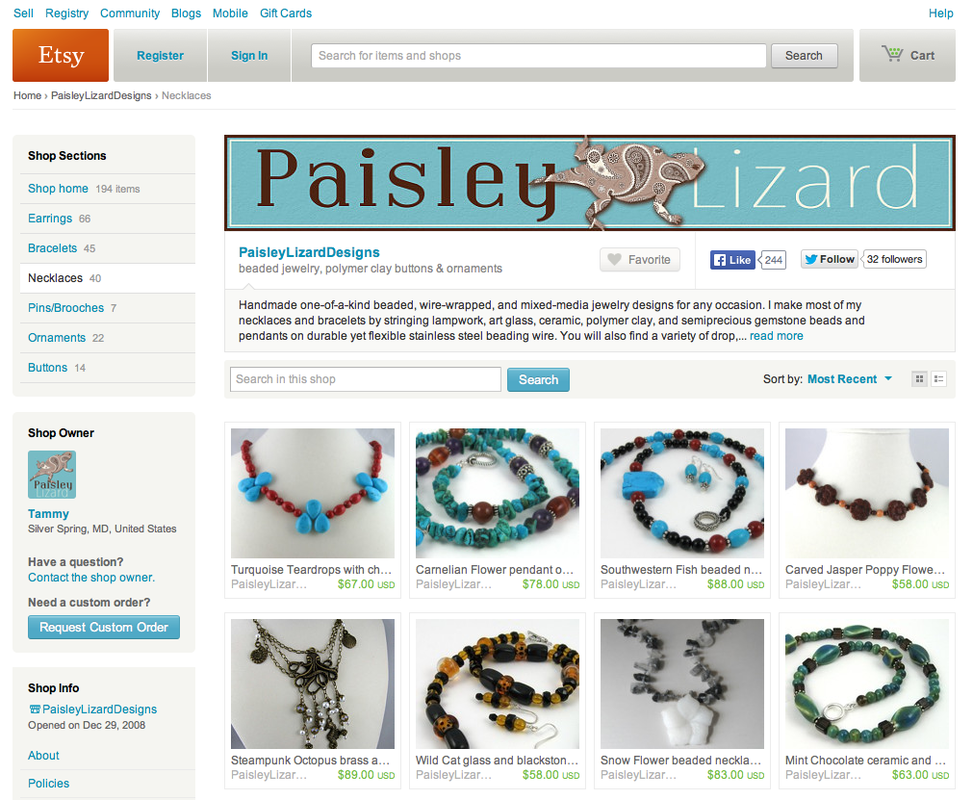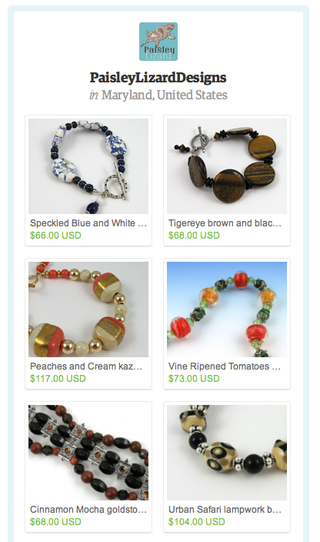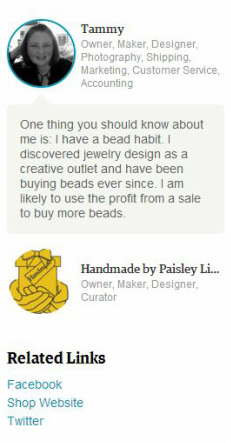I’ve been advising a friend who was trying to get her Etsy shop up and running. Well, actually, she wasn’t. Until I started nagging and peer-pressuring her into it. I acted out of love. I love her crocheted hats and headbands, and own more than a few. I get asked “where’d you get that?” every time I wear one. Followed by the inevitable: “Is she on Etsy?” (she is now – go check it out, and then come back here to finish reading)
She’s been selling via her Facebook page, and at craft shows, quite successfully. But having an online shop opens up a wider world of possible customers, including the handful of people who aren’t on FB. There are many marketplaces on the web where you can open a shop to sell your handmade goods. Etsy happens to be the one I stumbled upon first.
I am not an Etsy expert. I’ve had my own shop on Etsy for just over five years and am still learning. However, I realized as I was answering my friend’s questions, that you don’t need to be a professional NASCAR driver to be capable of helping a friend learn how to drive a car, right? So, here, in no particular order, are a few tips and advice from a somewhat “established” Etsy shop owner to anyone contemplating being one. Or too intimidated to contemplate starting.
Tip #1. Jump In!
It’s much easier than you might think to get started. To start, you need a shop name and banner, some general policies, some product photos and item descriptions. You don’t need 200 items to get started. You don’t even need 50 or 25. A handful of handmade items are all you need before you cut the ribbon and open the doors.
Your shop doesn’t have to be perfect and filled with hundreds of items on day one. Yes, first impressions are important and there are some things you should try to get “right” before you open. Just know that almost everything about your shop can be edited any time, and as often as you like. Your shop name is an exception. Which brings me to Tip #2.
Tip #2. Choose your shop (business) name wisely.
Choose a shop name that represents you and your products, and allows room to grow. Right now, you may only make hand-painted coffee mugs, so Jane’s Mug Shop seems like a fun and fitting name for your business on Etsy. But what if one day you start making hand-painted wine glasses and glass ornaments too? The name is still fun, but it no longer represents your product line.
You can change your Etsy shop name once without getting special permission from Etsy administrators. I did it. However, there are lots of reasons why it’s better to choose wisely and stick with it. Not the least of which is you want to avoid confusing customers or losing your customer base. Plus you’ll have to print new business cards, address labels, etc. Think of your shop name as a tattoo. It’s not entirely permanent, but getting rid of it can be a big pain and expense.
There’s lots of detailed advice out there on factors to consider when choosing and using a business name, like this article from Inc. Also consider the availability of your name for “cross platform branding,” meaning check to see that it (or a close version of it) are available everywhere you want to be, including Facebook, Flickr, your own website, etc.
If you have to add something like “The” to the front or “Designs” to the end to get a variation of your name elsewhere, it’s not ideal, but it’s much better than being “Paisley Lizard Designs” on Etsy and “Jewelry Designs by Tammy” on Facebook. Continuity is a key to memorability.
Tip #3. Choose banner and avatar images that represent your business.
There are two images that will be associated with your shop on Etsy: the shop banner and your avatar (which Etsy calls a profile picture). For your banner, which appears at the top of your main page and each section page, you might choose an image that reflects what you sell, like a photo collage of your items. Or you could use an image that represents your shop name, like my Paisley Lizard logo. If you do the later, design a logo that evokes a sense of your style. If you create pop art inspired clothing, don’t use a steampunk-styled banner image. Your banner is like the sign over the door of your store. Do use an image unique to you and your shop.
If you aren’t a graphic design expert, and don’t want to invest in software for it, there are people and companies who can design banner images for you. Search for “graphic design” on Etsy, if you want to work with a fellow Etsian. If you want to DIY, just search the web for “free Etsy banner” and you will find many templates and programs to help you create an image that’s the right dimensions to upload.
Your avatar image appears on your profile page, in your item listings, and next to your name when you make Treasuries or comment in the forums. Choose something eye-catching, memorable, and associated with your business. I recommend a scaled version of your logo. That way, where ever you go on Etsy, you are still advertising for your shop. If your shop banner is photos of your product, use one of those same photos for your avatar, for continuity.
Keep in mind your shop banner does not appear at the top of item listing pages. If people arrived at an item listing through a search or link, rather than from your home page, your avatar image communicates a visual cue about what shop that item is in.
Some people use a photo of themselves as an avatar. Keep in mind you also have an About page where you can put a photo of you, the person behind the product. That photo will also appear at the bottom of every listing. So, use your avatar to represent your shop and your product; and use the About page to show people who you are.
Tip #4. Take the best photos you can.
The better your photos are, the more engaging your item listing will be. Do you need to have five professional catalog quality photos of each item? Nope. Focus on having at least one well-lit photo of each item that shows its best attributes. You can use the same photo to fill two slots: one can be zoomed out to show the whole product, and the other can be zoomed in and cropped to highlight detail.
If there’s something special about the back, or side, make sure you have a photo of that angle too. Remember, you can edit your item listings any time, to add more photos or swap them out as you have time or learn to take better shots. I advise against using “filler” images, like your logo or your cat, simply for the sake of filling all five slots. If it doesn’t showcase or highlight something about the product, it detracts from it.
This Big List of Product Photography Tips for Etsy Sellers by Handmadeology is a nice resource for everything from what to look for in a digital camera and how to make your own light box, to how to style your photos and adjust backgrounds.
Tip #5. Write relevant item descriptions.
Use words that describe the key characteristics of the item. What size is it? What color? What is it made from? Who or what is it made for? Does it come in variations? Give customers all the pertinent facts to help them visualize in three-dimensions an item they are viewing on a flat monitor and not able to hold in their hands. Include the senses in your descriptors. Does it feel soft? Is it lightweight? Does it shimmer or sparkle?
Use nouns and adjectives that people are likely to input for search terms. Remember to state that it is handmade. Once you’ve covered the basics, elaborate on what is special about it. Is it one-of-a-kind? Do you have a matching something else in another listing? Can you make it in other colors, sizes, etc. as a custom order? You can also get personal and poetic, if you like. Tell customers what inspired you to make that piece, wax poetic about. Or not. Just be sure you’ve given enough detail to help the customer know why they need to have it.
Tip #6. Give it a SEO-friendly name.
Search Engine Optimization (SEO) is your friend. If you do it right, you increase traffic to your shop – for free. Use nouns and adjectives for your item titles that people are likely to input for search terms. You might call that necklace design “Layla” for the song that inspired it, but chances are slim potential customers will be searching the web or Etsy for a “Layla necklace.” (unless that’s their name). It’s more likely they will be searching for a “turquoise blue beaded necklace.” If you don’t want to sacrifice artistic expression for search engine visibility, you can have both: turquoise blue beaded “Layla” necklace. If you must.
Remember to use your Shop Announcement (text box under your banner on your main page) to briefly describe what’s in your shop. And use your Shop Title (gray text right under your shop name and banner on your main page) to summarize in a few words what’s in your shop. Try to use consistent words across the shop title, shop announcement, item titles, and item descriptions. For example, I might use “beaded” in all of these places because I make beaded jewelry.
I am no SEO expert and this is one area in my shop where I probably need the most improvement. I am slowly but systematically editing my item names and product descriptions to improve their visibility in searches. Handmadeology is an easily digestible source of information on this topic.
Tip #7. Give it a fair price.
You can find price calculators and formulas all over the web. It’s up to you to decide what numbers to input for hourly wage and profit margin. Don’t under-value your work. Choose a price that fairly represents the cost of the materials, your experience and skill, your artistic vision, and your time. Remember to pay yourself not just for how long it took to design and assemble the item itself, but also the time you will have spent taking and editing photos, writing the item description, and all the other things you have to spend your time on as the owner and operator of a small business.
I’ve said it before and I’ll say it again, handmade should not be synonymous with cheap. If you’re unsure whether your prices are “fair” you can browse Etsy to see how you compare to others selling similar items. Just don’t assume you’ll get more sales by setting prices at the low end of the spectrum. Perceived value plays a big role in sales. And once more from the chorus – don’t undervalue your work.
Tip #8. Fill in every section of your shop.
Start with your shop’s Policies section. This is where you tell people what forms of payment you accept, how you will package and ship their purchase, and under what circumstances you accept returns or exchanges. You can also add information about how you handle custom orders, or anything else you think might be a “frequently asked question” from buyers. Note that every item listing has a tab linking back to your policies. It isn’t necessary to put these details within the item description itself.
Let customers get to know you. Don’t overshare, but do be a real person. Fill in the About page, and the Shop Owner profile. These are places you can give customers some insight into your process, your inspiration, and your personality as an artist or craftsperson and owner of a small business.
This is a snapshot from the right column of my About page. With a friendly photo of me, and a logo for the All Handmade by ME team, of which I am a member. These photos appear below every item listing in my shop.
Note also the “Related Links” which are live links to where you can find me off Etsy. The About page is the only place you can have these live links to your Facebook page, Twitter account, or anywhere that’s not Etsy. Be sure to use them to your advantage.
You can also link your shop to your Facebook and Twitter accounts via buttons on your main page (under your banner) so people can click the buttons to “like” and “follow” you there.
Tip #9. Toot your horn.
Tell everyone you have an Etsy shop. Don’t be shy. Print business cards (with your logo! and the custom URL for your Etsy shop) and hand them out everywhere. Consider setting up a page on Facebook, starting a Twitter account, blogging, and using other forms of social media. It’s not a bad idea to grab your shop/business name on as many of these social sites as you think you might use, even if you won’t jump into them all at once.
Simply having a shop on Etsy, even a perfect shop with spectacular photos and search engine optimized text, will not bring you customers. It’s up to you to bring the customers to your shop. You are the grand marshal of that parade, so get steppin’.
Tip #10. Join a Team.
This is something I didn’t do during my first five years on Etsy, but should have. Participating in a team on Etsy is a great way to develop a support system among other artists, craftspeople, and small business owners who have some of the same questions, concerns, and aspirations as you. It’s also a great way to increase your exposure on Etsy. After all, many Etsy shop owners enjoy buying handmade and supporting fellow small businesses.
Just don’t over-extend yourself and join too many teams. Being a team member is a time commitment. Some teams require more participation than others. Join the right team for you, and invest an appropriate amount of time in the team’s forum, learning and sharing what you’ve learned. Make Treasuries that showcase team members’ work, and they will return the favor.
Bonus tip. Keep it fresh.
Remember to check in to your shop daily. Not just to see if you sold anything. Renew listings that are due to expire. Or, if you haven’t been able to list anything new for a while, renew a listing to bump your shop back up in the search results. Re-arrange your items periodically, to showcase different products, maybe by season or for special occasions like holidays.
Review your shop statistics and think about what changes you can make to your listings to drive more traffic to your shop. While you’re logged in, check your team’s forum to see what’s new in discussions and click through some team treasuries to show your support. Even if you aren’t listing new items often, you can keep your shop relevant by making updates to other parts of your profile.
Bottom line: Don’t try to be the perfect shop straight out of the gate, but do plan to always work on improvements. Don’t be afraid to ask questions or learn from mistakes. Be earnest and be patient with yourself. And most importantly, tell EVERYONE you have an Etsy shop. Toot toot! And good luck.
P.s. I didn’t define or explain all the Etsy-centric terms here. If you want to know more, Etsy has this Quick Start Guide as well as seller FAQs.
Disclaimer: I don’t work for Etsy and they didn’t pay me to write this. I’m not trying to promote Etsy per se, I’m just writing about what I know. I had a shop on Artfire for a while too. A lot of these tips would be as applicable there as any other online marketplace you choose. I encourage you to browse through those other marketplaces and find one where you think you and your product would feel most at home. You can have shops in more than one marketplace. As long you abide by the respective terms of use. Just keep in mind, that’s more time you’ll have to spend maintaining your online presence.



